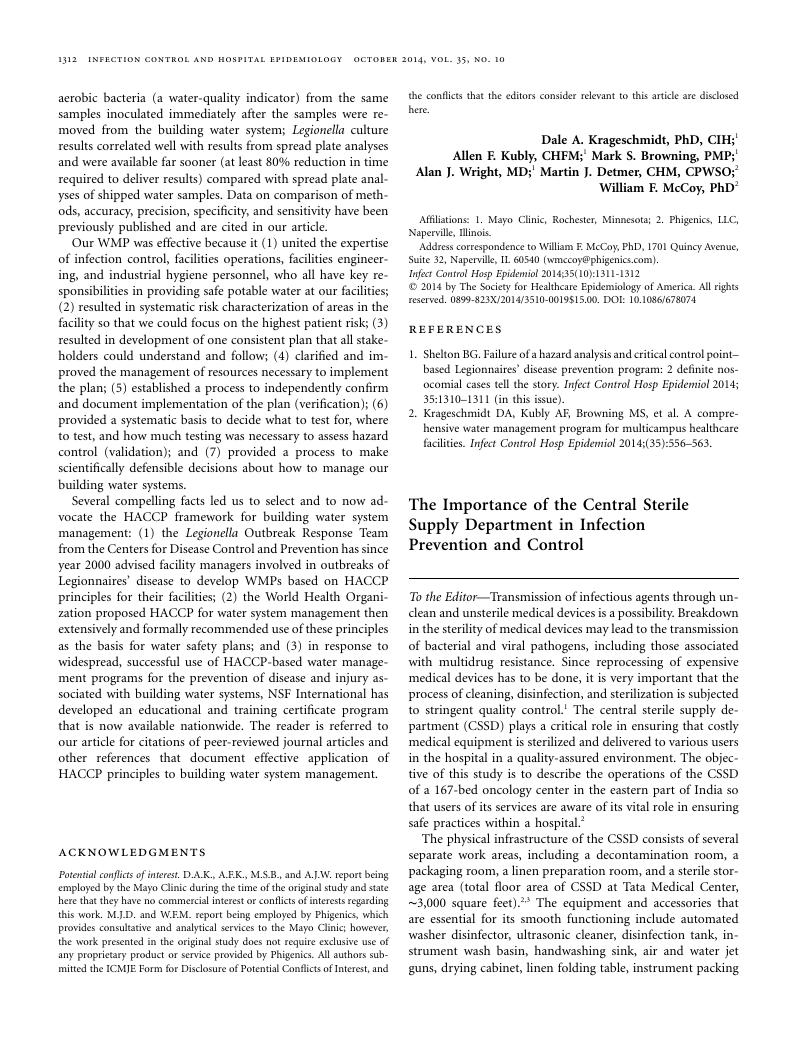Crossref Citations
This article has been cited by the following publications. This list is generated based on data provided by Crossref.
Basu, Debabrata
2015.
The Importance of Chemical Solutions Used for Cleaning Stainless Steel Surgical Instruments in the Central Sterile Supply Department.
Infection Control & Hospital Epidemiology,
Vol. 36,
Issue. 7,
p.
868.
Basu, Debabrata
Bhattacharya, Sanjay
Mahajan, Aseem
Ramanan, Venkata Raman
and
Chandy, Mammen
2015.
Sterilization Indicators in Central Sterile Supply Department: Quality Assurance and Cost Implications.
Infection Control & Hospital Epidemiology,
Vol. 36,
Issue. 4,
p.
484.
Tolson, Kerryanne
and
Friedewald, Mark
2016.
Beyond the patient zone: Improving hand hygiene performance in a Sterilising Services Department.
Infection, Disease & Health,
Vol. 21,
Issue. 1,
p.
11.
Basu, Debabrata
Dutta, Sanjay Kishore
Bhattacharya, Sanjay
Mahajan, Aseem Yogishwar
Ramanan, Venkata Raman
and
Chandy, Mammen
2016.
The Economics of Autoclave-Based Sterilization: Experience from Central Sterile Supply Department of a Cancer Center in Eastern India.
Infection Control & Hospital Epidemiology,
Vol. 37,
Issue. 7,
p.
878.
Basu, Debabrata
Bag, Subhas C.
Das, Arijit
and
Razario, John D.
2017.
The importance of paper records and their preservation period in a Central Sterile Supply Department: An experience from a oncology center in eastern India.
Journal of Infection and Public Health,
Vol. 10,
Issue. 5,
p.
685.
Basu, Debabrata
2017.
Reason behind wet pack after steam sterilization and its consequences: An overview from Central Sterile Supply Department of a cancer center in eastern India.
Journal of Infection and Public Health,
Vol. 10,
Issue. 2,
p.
235.
Moondra, Shruti
Raval, Nidhi
Kuche, Kaushik
Maheshwari, Rahul
Tekade, Muktika
and
Tekade, Rakesh K.
2018.
Dosage Form Design Parameters.
p.
467.
Forrester, Jared A.
Powell, Brittany Lynn
Forrester, Joseph D.
Fast, Christina
and
Weiser, Thomas G.
2018.
Surgical Instrument Reprocessing in Resource-Constrained Countries: A Scoping Review of Existing Methods, Policies, and Barriers.
Surgical Infections,
Vol. 19,
Issue. 6,
p.
593.
Wang, Li
Cai, Xuejiao
and
Cheng, Ping
2018.
Application of a sub-specialties management model improves quality control in a central sterile supply department.
BMC Health Services Research,
Vol. 18,
Issue. 1,
Basu, Debabrata
2019.
Requirement of hollow process challenge device for monitoring hollow and complex instruments sterilization: a simulator for proper sterility assurance.
Infection Control & Hospital Epidemiology,
Vol. 40,
Issue. 8,
p.
951.
Basu, Debabrata
Das, Arijit
and
Rozario, John Debdutta
2020.
A brief discussion on environmental quality monitoring required in a central sterile supply department: Evidence from a cancer center in eastern India.
Infection Control & Hospital Epidemiology,
Vol. 41,
Issue. 5,
p.
624.
Kraus, Veronika
and
Uzun, Yucel
2020.
Supporting Medical Auxiliary Work: The Central Sterile Services Department as a Challenging Environment for Augmented Reality Applications.
p.
665.
George, Biju
and
Bhattacharya, Sanjay
2020.
Contemporary Bone Marrow Transplantation.
p.
1.
George, Biju
and
Bhattacharya, Sanjay
2021.
Contemporary Bone Marrow Transplantation.
p.
545.
Hiremath, Savitha B.
Renushree, B. V.
Vinod, R.
and
Shilpa, P.
2021.
An audit of infection control practices in Central Sterile Supply Department in a Tertiary Care Hospital, Puducherry.
BLDE University Journal of Health Sciences,
Vol. 6,
Issue. 2,
p.
127.
Ying, Jia
Wang, Haiying
Ye, Hui
Du, Cuiqi
Mao, Lili
and
Tang, Min
2022.
The Supervision and Management Mode of Disinfection Supply Center Improves the Standardization of Sterile Goods Management in Clinical Departments.
Computational and Mathematical Methods in Medicine,
Vol. 2022,
Issue. ,
p.
1.
Garg, Ajay
and
Dewan, Anil
2022.
Manual of Hospital Planning and Designing.
p.
321.
Chen, Hui
Liu, Jiawei
and
Zhang, Mengmeng
2023.
Incidence of Adverse Events in Central Sterile Supply Department: A Single-Center Retrospective Study.
Risk Management and Healthcare Policy,
Vol. Volume 16,
Issue. ,
p.
1611.
Garg, Ajay
2023.
Monitoring Tools for Setting up The Hospital Project.
p.
505.



